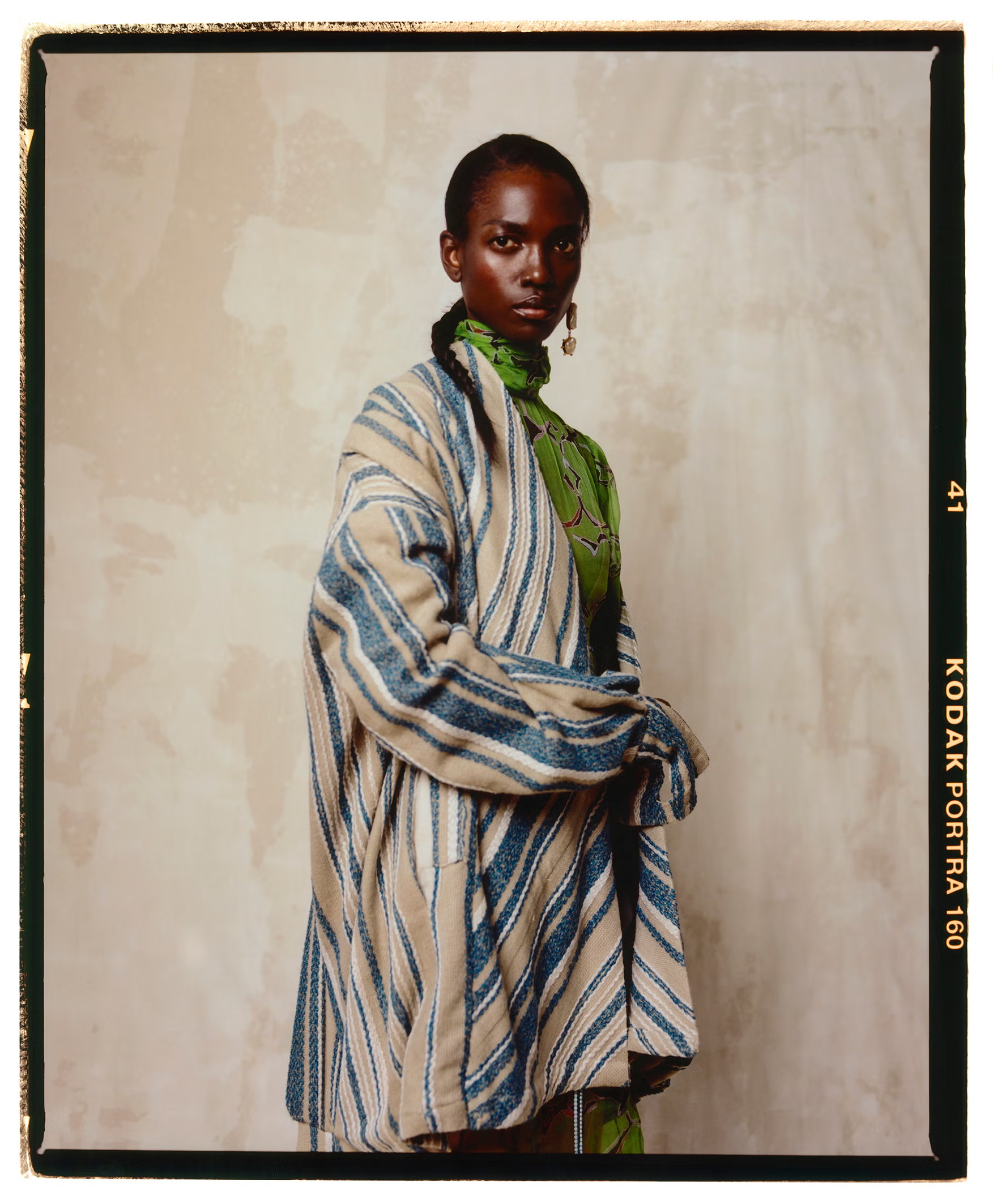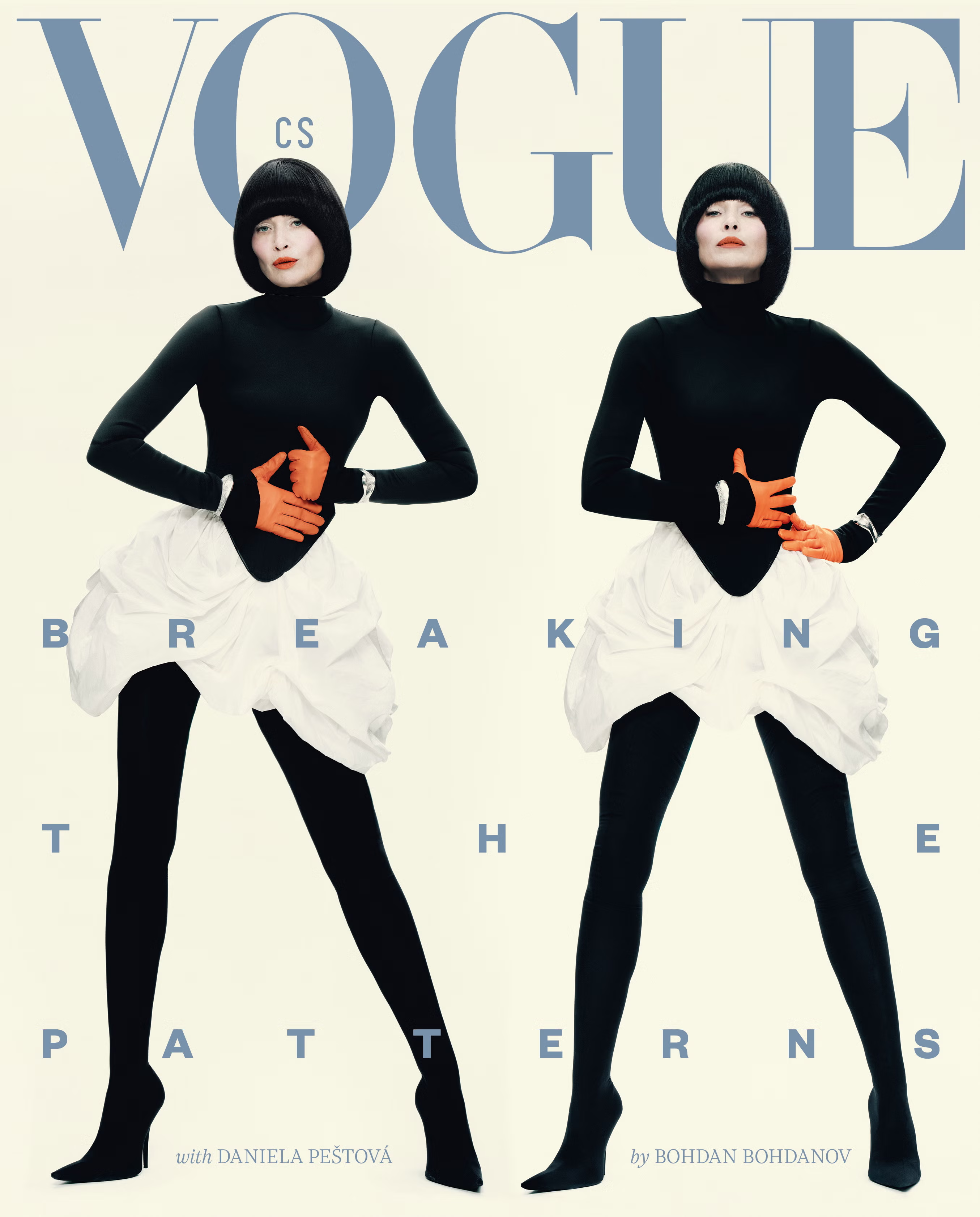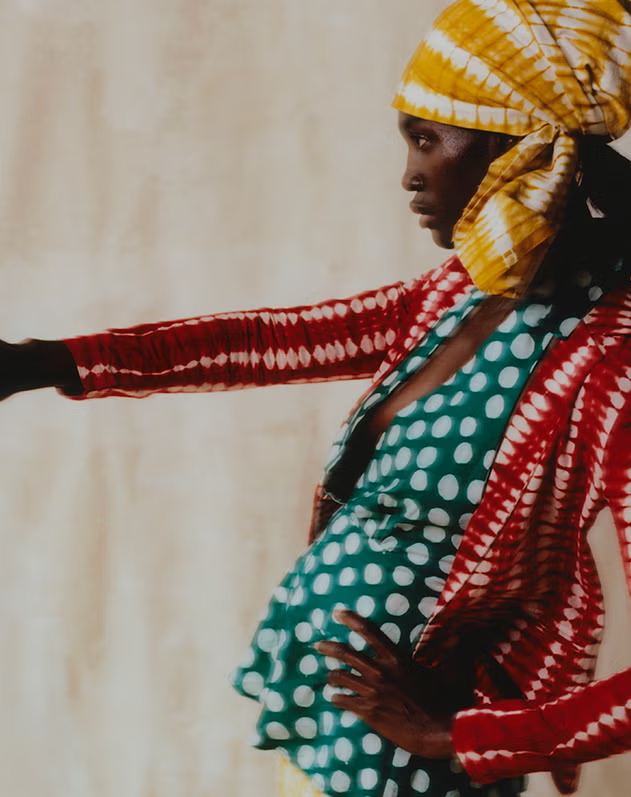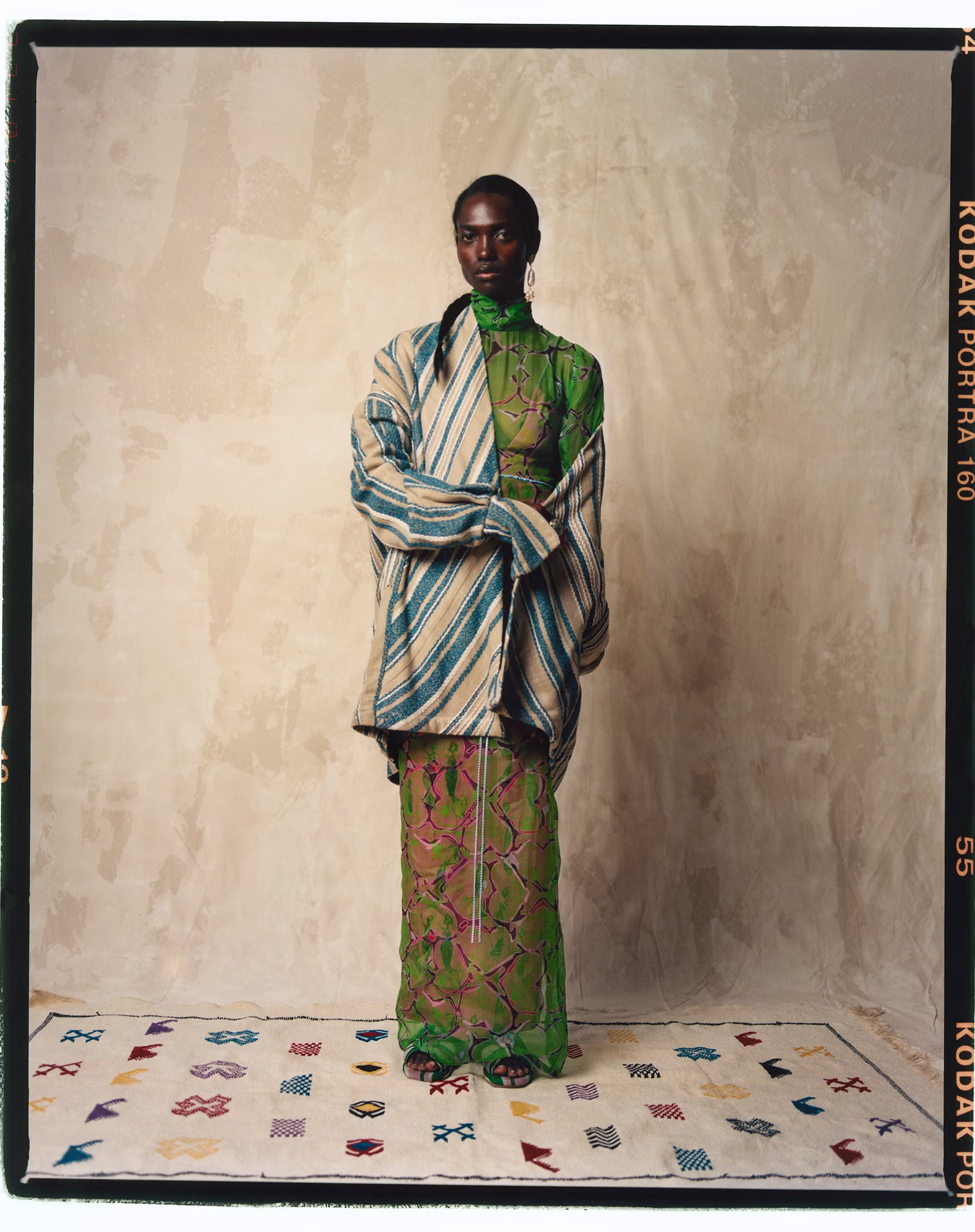Vogue CS in English

Interview with Gloria Wavamunno of GWAVAH
Ooooota Adepo1. 8. 2020

Foto: Rhys Frampton
Dress, Lisa Folawiyo (sold at Koibird); blazer, Gloria Wavamunno; ring, earrings, all Vintage.
Ooooota: As an artist, because I know you also paint, what does fashion mean to you? Why did you choose it as a profession?
Gloria: I was fortunate to have supportive parents encourage my artistic mind, which at times isn’t a priority in Africa. It led me to questioning things and wanting to find my sense of comfort with them. When you’re an artist, you’re a bit reserved and observant sometimes. Painting was one way I could express myself.
My mom happened to be in tailoring and as a child, I saw her and my aunts put beautiful materials together to create dresses for women, and I thought, wow. Observing the tailoring business, I got to see the interaction. It wasn’t just a store. It was very one-on-one with the clientele to figure out what they want, measuring it to their size and more. It showed me what power clothes seem to have on people. As I got older, I figured painting might not be a viable career. At the time it was difficult to be just an artist. I knew I wanted to be in art, but I needed something that was profitable because I come from a family of entrepreneurs. Clothes were a way I thought, okay, I can put my artistic feel into them and create pieces that touch people. As I got older in the fashion industry, I realized I didn’t have to tailor what people want. I could tailor what I want. That started my journey down this continuous path of what and why I create.

Gloria Wavamunno
Ooooota: Explain the evolution of the Gloria Wavamunno aesthetic since your first collection.
Gloria: The evolution of Gloria Wavamunno, aka GWAVAH. That’s the evolution. Having a new way to phrase my pieces in the short, more simplistic sense. I started sculpting and painting with my clothes. I was very inspired by Alexander McQueen’s structural storytelling, making clothes an art piece. I made things that were very structured, and I played around with a lot of leather. I’ve always been into playing around with fabrics that aren’t normally used – recycled curtains, inner cushions of sofas etc. I was trying to be creative but also cost efficient. Coming from a business-minded family, I was always trying to find a way to make my brand a creative business, conscious of expenses. If I couldn’t afford a beautiful luxurious fabric, I would have to consider an alternative. I also considered the consumer, myself included, and how they would want to spend their money. I wanted people to have pieces that don’t break their bank account. With my evolution, the more I grew, the more I learned what I want to wear and what works best for me. Considering [my] masculine and feminine energies, I wanted to be comfortable and to wear things that could get me from A to B to Z. I moved from harder fabrics to softer fabrics. I also wanted to work more local, so considering what was most available, such as jersey which our Muslim community often uses, I realised I wanted to play with that. We have hot weather, so I wanted things that are breathable. That fabric works and is good to manipulate and play with. Jersey allowed me to play in the same way I played with paints and colours. The aesthetic now is soft and flowy but with detail. My philosophy has always been about evolution and change. I find that now in clothes adaptable to your body, that bring out a positive aspect. The nature around us is very green and spiritual. I’m harnessing that element too. I’m using my experiences and things I’m interested in to create non-binary pieces that flow for different occasions.
Ooooota: Talk to us about Kampala Fashion Week. Why did you create it? How do you see it evolving?
Gloria: Kampala Fashion Week (KFW) started in 2014. This is the 7 year. It stemmed from my experiences, as I had worked in different fashions shows and for different designers. The runway seemed to be a huge marketing space for designers. I was thinking of what we didn’t have back home (resources, financial support, experience, education) and how I could translate this process to Uganda. First, I thought education, which played a huge part in putting me in the fortunate positions I’ve been in. I thought that’s what has to be the main focus. As much as KFW has the fashion weeks, it’s about the organizational structure and training. But KFW allows designers to benefit from the necessary marketing hype. We have to also consider how to present them positively. How do they produce and meet quality standards and meet international guidelines, yet establish confidence locally? KFW was created to show the rest of the world what we are capable of while also being a facility to handle things we lacked – education, training, skills and the passion we should have as artists from Africa. I see it evolving. With COVID-19 and social distancing, it’s pushing Africa into a faster digital age. We had old-school methods for certain businesses. I think designers will learn to become more digital. You don’t have to put your clothes in other peoples’ stores. You can make your own website. People will get more digital in displaying their clothing on the multiple social media platforms that we have access to.
Ooooota: How important is it to you for African designers and artists to collaborate?
Gloria: I think it’s always been important. Collaborations are always helpful, inspiring and lead to innovative ideas. With African designers there is a new world where we are re-educating ourselves on each other’s cultures, histories and narratives. Collaborating gives us more one-on-one contact to really dive into everyone’s spaces and find the best stories, and at the same time on the ground learning what challenges we’re all going through in different countries and cities. With the internet and travel and culture, what are we doing with that? How are we bringing that home? Also re-inventing our identity. We also have the ability to change and evolve traditions. This is a new time. How together can we create beautiful pieces of work that support sustainability, job training, skills and innovation? We can also start redefining currency. Is it finances? Is it time? Is it materials? We’re all very blessed with different materials across the continent, so it’s about finding ways to exchange things that we all need, supporting each other in the process.
Ooooota: Is GWAVAH an ethical fashion line? Is it important for consumers to consider sustainability in their fashion choices?
Gloria: In terms of my mission and philosophy, GWAVAH has been an ethical fashion line from the beginning. Initially, it was an education. I wanted to know all the possibilities I had and the challenges with each. Sometimes you need to know what is non-ethical to know what is actually ethical and not just trendy or hyped. For me what is ethical is that I want my team to be happy and feel valued, financially and mentally. I want them to feel the brand allows them a space to grow. That to me is ethicalness. Also, it is being conscious of local purchasing and local support. Supporting my local economy rather than supporting an economy somewhere else which is very important for a developing nation. I’m buying fabrics from a local store but sometimes I don’t know where the fabrics are shipped from. Sometimes you have to just think basically and do what you can do. One person can’t save the world but each of us can do something. To me being ethical is being conscious - conscious of what I am and conscious of what I’m making. Being conscious also allows you to build a more economical business model as you can better manage your resources and put money where it’s meaningful. Each designer has to find out what ethicalness is to them. Each person knows what their financial situation is and what they’re capable of. Lumping us all together in one box never works. As long as you’re not trying to destroy things, you’re okay. We need to give people room to evolve and grow.
Ooooota: What inspires you as an artist? As a designer? As a human being?
Gloria: Being alive is part of what I’m inspired by as an artist. Multifaceted ways of being and existing and how it’s all connected. Connecting the dots. The artist side of me and the human side of me are very close together. Even with the designer part of myself, it’s always the artist first. It’s connected to the earth. The planet is such a beautiful and inspiring place. Everyday I’m shocked when I learn about a new plant, or a new animal. I’m very blessed that I’m from Uganda, the Pearl of Africa as they say. We’re on the equator and we’re lush in nature, so I’m spoiled with that. It fuels me and has fuelled me, knowing I’d build my career here. Also, being on the journey of ageing and finding your identity and trying to remove labels but figuring out the ones that work for you. It all moves into how I create and feel. I’m really sensitive and I’m sure most artists would say that. I’m now realizing what a blessing my sensitivity has been. The mistakes that have come through the sensitivity have helped me realize what being alive and awake on this planet really is.
Ooooota: How can the fashion industry in Africa grow to the point of being self-sufficient?
Gloria: From my experience and observation, time. Time is always really important. There are so many Africans all over finding solutions and creating infrastructure in their spaces which is really hopeful. Growing up, there were no art programs or grants. Now there is development. Grants, funds, residencies. You can be an African local and have access to grants. It is going to be more working with each other and breaking down the Western understanding of capitalism, which will not be healthy for us. If we can forge our own identity with the information we’ve acquired from systems we’ve watched, let’s take the good out of some and leave the bad, and try to evolve from there. Since COVID-19 much is changing. I’m in groups with fashion week founders around the continent. I’m in groups with designers across the diaspora. To be in Whatsapp groups with all these people you didn’t have access to before, that’s pretty big. There’s a huge shift that’s happening and it will be interesting to see where it goes. I’m already in awe and inspired by seeing how we can all come together humbly but how we can work together to change, improve and support in our own way.
Ooooota: Is it difficult to find seamstresses, tailors and pattern makers with the skills necessary to produce quality clothing in Uganda?
Gloria: it has been difficult in the past. When I was growing, the skillset of a tailor and seamstress was not up to par of what I’d experienced. Since I was able to learn as a kid watching my mom and aunts, I thought - then anyone can. Schools that can churn out people at higher-level skillsets, but the natural talent of skill is always there within humans. It’s about finding the opportunity to give that support. I was conscious of that when I moved back to Uganda, knowing I wanted to create an educational studio with books and where we train, test, and sample. For a while at my studio we were just playing because that was necessary to get everyone up to the skill requirement of quality. I think I’m good at picking tailors, and they’ve all learned really quickly. All they needed was guidance which is what I was there to give. Now there are more spaces to train so there’s generally better quality in clothing production. People are constantly learning.
Ooooota: How can education around fashion in Africa address many of the problems the industry faces?
Gloria: Access, I think. Education is there but where is its reach? There are different points of accessibility. Some people don’t have Android phones so they can’t look at Youtube all the time. The schooling system will change after COVID-19. Now a team of 5 can’t be a team of 5 at the same time together. Online courses are very important. We would do pop ups during festivals around Uganda where we show people how to pattern etc. We used to run training internships which was my way of giving back. Giving back that knowledge is so important. I tell my tailors and seamstresses that if you have an opportunity to teach, then teach. But teach so that people feel it, which is what I think makes a great tailor. It’s not always this mechanical thing. I think real energy and care goes into clothes when you feel it and it’s flowing from the person creating. I know my team has such a heart and they flow into my clothing. That energy is what makes my clothing what it is.
Ooooota: How involved (or not involved) do you think the European fashion industry and market should be in supporting and/or collaborating with African talent?
Gloria: Now I feel there more opportunities coming. Many schools from Europe, the Netherlands for instance, are reaching out wanting to do exchange programs. I feel since Europe takes a lot of inspiration and creativity from the continent, they should be exchanging back educational courses and grants and providing teachers from their side and vice versa. It’s this word ‘exchange’ that I’m very fond of versus ‘help’ and ‘handouts’. That whole narrative is a bit over and boring. We all have an ability to be great forces if we have the tools and support systems to guide and elevate us. We don’t need a condescending ‘give back because we feel bad’ mission. The Western fashion industry also needs to clean up its own act. A lot of clothes produced in the US are manufactured in Asia and Africa. There needs to be a restructuring of organizations to create better communication. The exchange needs to evolve - give and take, take and give and hopefully grow from there.
Ooooota: What’s next for you?
Gloria: I don’t like to over plan things, particularly now. Right now, Fashion Council Uganda is creating its base and I want to focus more on that. KFW was about fashion shows but with the message of training and safe spaces and acceptance. So, looking into grants that give us the power to restructure things on the ground based on local knowledge is important. Much has been evolving in the past few years. I want to be more involved in organization. I don’t want to just be a garment designer. I’ve moved into accessories in the last 3 years, now I’m adding jewellery playing with cowrie shells which has so much history and symbolism. In general, my aim is to try to continue to create. To evolve myself in my own creation. To support other beings in their creation of themselves, and to create a safe space for that. And continue to be that observer, watching the world. Moving and flowing with it. I’ve met the most amazing people on this journey. It’s been a wild and joyful ride through the ups and downs. I’m just grateful to be alive and standing and looking forward to the next steps I’m destined to take.



